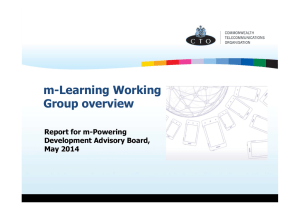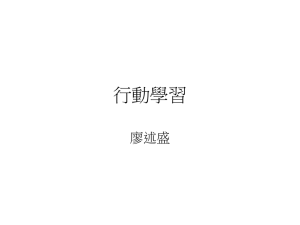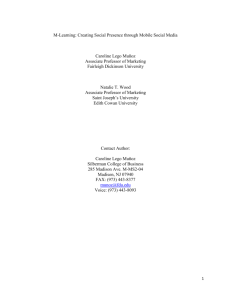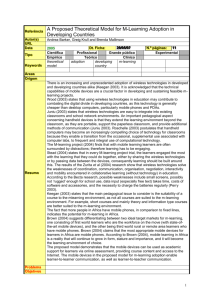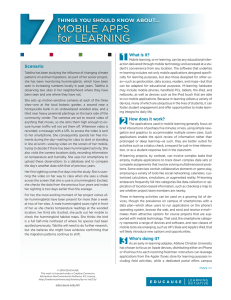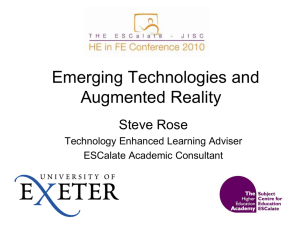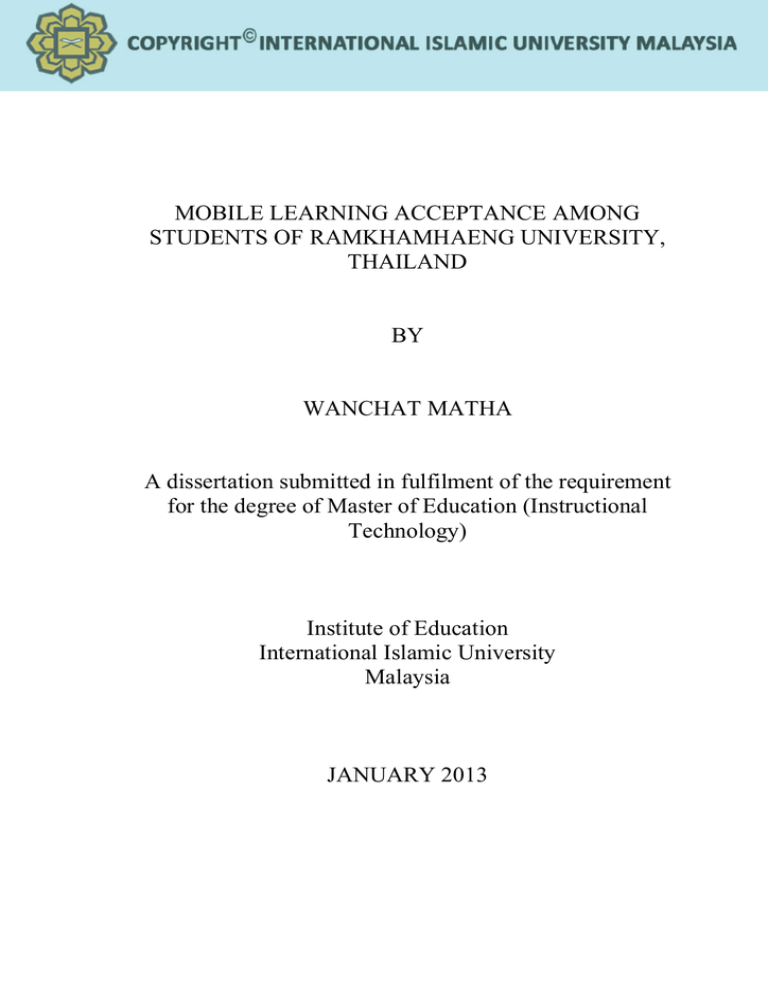
MOBILE LEARNING ACCEPTANCE AMONG
STUDENTS OF RAMKHAMHAENG UNIVERSITY,
THAILAND
BY
WANCHAT MATHA
A dissertation submitted in fulfilment of the requirement
for the degree of Master of Education (Instructional
Technology)
Institute of Education
International Islamic University
Malaysia
JANUARY 2013
ABSTRACT
The rapid growth of mobile technology will push educational institutions to adopt
mobile learning (m-learning). It has the potential to allow students to more closely
integrate with learning activities in their lives. However, its adoption and level of use
is low in Thailand compared to other countries. This study aims to measure and
understand students’ perceptions on the use of m-learning in Thailand education
system. Besides, this study is also interested in identifying factors that affect the
adoption of m-learning in Thailand. The Technology Acceptance Model (TAM) is
used as theoretical framework towards understanding the adoption of m-learning. The
quantitative method was applied to collect primary data from 200 Ramkhamhaeng
University (RU) students who use m-learning. The findings reveal that the majority of
RU students were optimistic with the use of m-learning in Thailand education. They
believed that m-learning offers new learning experience, and could help them to
access course materials anywhere and anytime. In addition, it was discovered that only
three factors contributed significantly towards adoption of m-learning among RU
students. The factors were Thai Social Influence, Student Readiness, and Quality of
Content. Thai Social Influence was found to be the most influential factor in the
model. On the other hand, factors such as Perceived Usefulness, Perceived Ease of
Use, and Network Accessibility were found to insignificantly contribute predictors on
m-learning adoption. Finally, tests conducted along the different individual
characteristics reveal that prior experience has significant affect on their behavioural
intention to use. However, gender and faculty variables would not affect their
intention to use m-learning. This research provides useful information in the
understanding students’ acceptance of m-learning in RU. Moreover, it also gives
perspectives to RU and other institutions who want to integrate m-learning system into
their curricula.
ii
ﻣﻠﺨﺺ اﻟﺒﺤﺚ
اﻟﻨﻤﻮ اﻟﺴﺮﻳﻊ ﻟﺘﻜﻨﻮﻟﻮﺟﻴﺎ اﳍﺎﺗﻒ اﻟﻨﻘﺎل ﺳﺘﺪﻓﻊ اﳌﺆﺳﺴﺎت اﻟﺘﻌﻠﻴﻤﻴﺔ إﱃ ﺗﺒﲏ اﻟﺘﻌﻠﻢ اﻟﻨﻘﺎل )م – اﻟﺘﻌﻠﻢ(.
ﺣﻴﺚ اﻧﻪ ﻳﺴﻤﺢ ﻟﻠﻄﻼب ﺑﺪﻣﺞ أﻧﺸﻄﺔ اﻟﺘﻌﻠﻢ ﺑﺸﻜﻞ وﺛﻴﻖ ﰲ ﺣﻴﺎﻢ .وﻣﻊ ذﻟﻚ ،ﻓﺈن اﻋﺘﻤﺎدﻩ
واﺳﺘﺨﺪاﻣﻪ ﺑﺘﺎﻳﻼﻧﺪ ذو ﻣﺴﺘﻮى ﻣﻨﺨﻔﺾ ﻣﻘﺎرﻧﺔ ﻣﻊ اﻟﺒﻠﺪان اﻷﺧﺮى .ﺪف ﻫﺬﻩ اﻟﺪراﺳﺔ ﻟﻘﻴﺎس وﻓﻬﻢ
ﻣﻔﺎﻫﻴﻢ اﻟﻄﻼب ﻋﻠﻰ اﺳﺘﺨﺪام اﻟﺘﻌﻠﻢ اﻟﻨﻘﺎل ﰲ اﻟﺘﻌﻠﻴﻢ ﺑﺘﺎﻳﻼﻧﺪ .إﱃ ﺟﺎﻧﺐ ذﻟﻚ ﺘﻢ ﻫﺬﻩ اﻟﺪراﺳﺔ
ﻛﺬﻟﻚ ﰲ ﲢﺪﻳﺪ اﻟﻌﻮاﻣﻞ اﻟﱵ ﺗﺆﺛﺮ ﻋﻠﻰ ﺗﺒﲏ اﻟﺘﻌﻠﻢ اﻟﻨﻘﺎل ﺑﺘﺎﻳﻼﻧﺪ" .ﳕﻮذج ﻗﺒﻮل اﻟﺘﻜﻨﻮﻟﻮﺟﻴﺎ" ﻫﻮ
اﳌﺴﺘﺨﺪم ﻛﺈﻃﺎر ﻧﻈﺮي ﳓﻮ ﻓﻬﻢ اﻟﺘﺒﲏ ﻟﻠﺘﻌﻠﻢ اﻟﻨﻘﺎل .ﳉﻤﻊ اﻟﺒﻴﺎﻧﺎت اﻷوﻟﻴﺔ ﻓﻘﺪ ﰎ ﺗﻄﺒﻴﻖ اﻷﺳﻠﻮب
اﻟﻜﻤﻲ ﻋﻠﻰ ﻣﺌﺘﲔ ﻃﺎﻟﺐ ﻣﻦ "ﺟﺎﻣﻌﺔ راﳐﺎﻣﻬﺎﻧﻎ" ،اﻟﺬﻳﻦ ﻳﺴﺘﺨﺪﻣﻮن اﻟﺘﻌﻠﻢ اﻟﻨﻘﺎل .ﻛﺸﻔﺖ اﻟﻨﺘﺎﺋﺞ
ﺑﺄن ﻏﺎﻟﺒﻴﺔ ﻃﻼب "ﺟﺎﻣﻌﺔ راﳐﺎﻣﻬﺎﻧﻎ" اﻟﻠﺬﻳﻦ ﻳﺴﺘﺨﺪﻣﻮن اﻟﺘﻌﻠﻢ اﻟﻨﻘﺎل ﻣﺘﻔﺎﺋﻠﻮن ﺑﺎﺳﺘﺨﺪاﻣﻪ ﰲ ﺗﻌﻠﻴﻢ
ﺗﺎﻳﻼﻧﺪ .ﺣﻴﺚ ﻳﻌﺘﻘﺪون ﺑﺄن اﻟﺘﻌﻠﻢ اﻟﻨﻘﺎل ﻳﻌﺮض ﻓﺮﺻﺔ ﺟﺪﻳﺪة ﳋﱪة اﻟﺘﻌﻠﻢ ،وﳝﻜﻦ أن ﻳﺴﺎﻋﺪﻫﻢ
ﻟﻠﻮﺻﻮل إﱃ ﻣﻮاد اﻟﺪراﺳﺔ ﻣﻦ أي ﻣﻜﺎن وﺑﺄي وﻗﺖ .ﺑﺎﻹﺿﺎﻓﺔ إﱃ ذﻟﻚ ﰎ اﻛﺘﺸﺎف ﺛﻼﺛﺔ ﻋﻮاﻣﻞ ﻓﻘﻂ
ﺳﺎﳘﺖ ﺑﺸﻜﻞ ﻛﺒﲑ ﳓﻮ ﺗﺒﲏ اﻟﺘﻌﻠﻢ اﻟﻨﻘﺎل ﺑﲔ ﻃﻼب "ﺟﺎﻣﻌﺔ راﳐﺎﻣﻬﺎﻧﻎ" .ﻫﺬﻩ اﻟﻌﻮاﻣﻞ اﻟﺜﻼث ﻫﻲ:
ﺗﺄﺛﲑ اﺘﻤﻊ اﻟﺘﺎﻳﻠﻨﺪي ،اﺳﺘﻌﺪاد اﻟﻄﺎﻟﺐ ،و ﺟﻮدة اﶈﺘﻮى .وﻗﺪ ُوﺟﺪ اﻟﺘﺄﺛﲑ اﻻﺟﺘﻤﺎﻋﻲ أﻛﺜﺮ اﻟﻌﻮاﻣﻞ
ﺗﺄﺛﲑاً ﰲ اﻟﻨﻤﻮذج .ﻣﻦ ﺟﻬﺔ أﺧﺮى ،اﻟﻌﻮاﻣﻞ اﻟﺜﻼث اﻷﺧﺮى ﻟﻠﺘﻌﻠﻢ اﻟﻨﻘﺎل أﻧﻪ :ﻧﺎﻓﻊ ،ﺳﻬﻮﻟﺔ اﻻﺳﺘﺨﺪام،
ووﺟﺪ ﺑﺄن ﺳﻬﻮﻟﺔ اﻟﻮﺻﻮل ﻟﺸﺒﻜﺔ اﻟﻌﻤﻞ ﺳﺎﳘﺖ ﺑﺸﻜﻞ ﺗﻨﺒﺆي ﰲ ﺗﺒﲏ واﻋﺘﻤﺎد اﻟﺘﻌﻠﻢ اﻟﻨﻘﺎل .وأﺧﲑا،
ُ
ﻛﺸﻔﺖ اﻟﺘﺠﺎرب اﻟﱵ أﺟﺮﻳﺖ ﻋﻠﻰ ﺧﺼﺎﺋﺺ اﻟﻔﺮد اﳌﺨﺘﻠﻔﺔ ﺑﺄن اﳋﱪة اﳌﺴﺒﻘﺔ ﳍﺎ ﺗﺄﺛﲑ ﻛﺒﲑ ﻋﻠﻰ اﻟﻨﻮاﻳﺎ
اﻟﺴﻠﻮﻛﻴﺔ ﻟﻼﺳﺘﺨﺪام .وﻣﻊ ذﻟﻚ ،ﻓﺈن اﺧﺘﻼف اﳉﻨﺴﲔ واﻟﻜﻠﻴﺎت ﻟﻦ ﻳﺆﺛﺮ ﻋﻠﻰ ﻧﻮاﻳﺎ اﻷﺷﺨﺎص ﰲ
اﺳﺘﺨﺪام اﻟﺘﻌﻠﻢ اﻟﻨﻘﺎل .ﻫﺬا اﻟﺒﺤﺚ ﻳﻘﺪم ﻣﻌﻠﻮﻣﺎت ﻣﻔﻴﺪة ﰲ ﻓﻬﻢ ﻗﺒﻮل اﻟﻄﻼب ﻟﻠﺘﻌﻠﻢ اﻟﻨﻘﺎل ﰲ
"ﺟﺎﻣﻌﺔ راﳐﺎﻣﻬﺎﻧﻎ" .وﻋﻼوة ﻋﻠﻰ ذﻟﻚ ﻓﺈﻧﻪ ﻳﻮﻓﺮ أﻳﻀﺎً وﺟﻬﺎت ﻧﻈﺮ ﻣﻨﺴﻮﰊ "ﺟﺎﻣﻌﺔ راﳐﺎﻣﻬﺎﻧﻎ" و
اﳌﺆﺳﺴﺎت اﻷﺧﺮى اﻟﱵ ﺗﺮﻳﺪ دﻣﺞ اﻟﺘﻌﻠﻢ اﻟﻨﻘﺎل ﰲ ﻣﻨﺎﻫﺠﻬﻢ اﻟﺪراﺳﻴﺔ.
iii
APPROVAL PAGE
I certify that I have supervised and read this study and that in my opinion, it conforms
to acceptable standards of scholarly presentation and is fully adequate, in scope and
qualify, as a dissertation for degree of Master of Education (Instructional
Technology).
…………………………………..
Kamal Basha Madarsha
Supervisor
I certify that I have read this study and that in my opinion, it conforms to acceptable
standards of scholarly presentation and is fully adequate, in scope and qualify, as a
dissertation for degree of Master of Education (Instructional Technology).
…………………………………..
Mohd Burhan Ibrahim
Examiner
This dissertation was submitted to the Department of Curriculum and Instruction and
is accepted as a fulfilment of the requirement for the degree of Master of Education
(Instructional Technology).
…………………………………..
Muhamad Zahiri Awang Mat
Head, Department of Curriculum
and Instruction
This dissertation was submitted to Institute of Education and is accepted as a
fulfilment of the requirement for the degree of Master of Education (Instructional
Technology).
…………………………………..
Rosnani Hashim
Dean, Institute of Education
iv
DECLARATION
I hereby declare that this dissertation is the result of my own investigations, except
where otherwise stated. I also declare that it has not been previously or concurrently
submitted as a whole for any other degrees at IIUM or other institutions.
Wanchat Mathat
Signature………………………………
Date……………………………
v
INTERNATIONAL ISLAMIC UNIVERSITY MALAYSIA
DECLARATION OF COPYRIGHT AND AFFIRMATION
OF FAIR USE OF UNPUBLISHED RESEARCH
Copyright © 2013 by International Islamic University Malaysia. All rights reserved.
MOBILE ACCEPTANCE AMONG STUDENTS OF
RAMKHAMHAENG UNIVERSITY, THAILAND
I hereby affirm that The International Islamic University Malaysia (IIUM) holds all
right in the copyright of this Work and henceforth any reproduction or use in any
form or by means whatsoever is prohibited without the written consent of IIUM. No
part of this unpublished research may be reproduced, stored in a retrieval system, or
transmitted, in any form or by means, electronic, mechanical, photocopying,
recording or otherwise without prior written permission of the copyright holder.
Affirmed by Wanchat Matha
……………………….
Signature
………………………
Date
vi
To my mother, Kham Matha who have made endless sacrifice throughout their life.
Jazakumallah KhairaljazÉ’. RabÊ iqfirli wa li-walidayya wa irham humÉ kamÉ
rabbayÉnÊ Îagira.
Thank to my beloved wife, Nadeeroh Awaeputeh, and to my beloved daughter,
Wan Nurfatin Matha binti Wan MOHD, who always support and give me strength to
complete my work
vii
ACKNOWLEDGEMENTS
Alhamdulillah, all praise belongs to Allah, the Lord of the Universe who Mercy,
Guidance and Blessings have enabled me to complete this thesis successfully. Peace
and Blessing of Allah be upon His messenger, Muhammad S.A.W.
At the end of a long incubation period, this thesis has finally seen the light of day. It
would have remained forever dormant if it had not been for the help and
encouragement of a great many people.
I am gratefully indebted to my supervisor, Associate Professor Dr. Kamal Basha
Madarsha, his insight, knowledge, and enormous grasp of all matters relating to
education and administration phenomenal. Without his encouragement, I would never
have considered it worthwhile to document this. May Allah rewards and blesses him.
In addition, my heartfelt appreciation goes to Assistant Professor Dr. Mohd Burhan
Ibrahim, the second reader who willingly offers his invaluable insights and comments.
His deep concern and interests are highly appreciated.
I feel a great sense of gratitude to all lecturers of the Institute of Education in the
International Islamic University, Malaysia for their efforts and sincerity in teaching.
To colleagues and administrative staff, who either directly or indirectly contributes
throughout the course of this study, words cannot express my gratitude.
Thank you to all arousing questions from my friends and colleges to wake me up from
my slumber especially, my beloved wife Nadeeroh and my beloved daughter Wan Nur
Fatin who serves as my inspiration in finishing this research.
May Allah bless all of us, Ameen.
viii
TABLE OF CONTENTS
Abstract .......................................................................................................................... ii
Abstract in Arabic ......................................................................................................... iii
Approval Page ............................................................................................................... iv
Declaration Page ............................................................................................................ v
Copyright Page.............................................................................................................. vi
Acknowledgements ..................................................................................................... viii
Table of Contents .......................................................................................................... ix
List of Tables ............................................................................................................... xii
List of Figures ............................................................................................................. xiii
CHAPTER ONE: INTRODUCTION ........................................................................ 1
Background of the Study .................................................................................... 1
Mobile Learning in Thailand ...................................................................... 3
Ramkhamhaeng University ......................................................................... 4
Mobile Learning in Ramkhamhaeng University ................................. 5
Statement of Problem ......................................................................................... 6
Purpose of the Study ........................................................................................... 9
Conceptual Framework ....................................................................................... 9
Research Objectives and Research Questions .................................................. 10
Significance of the Study .................................................................................. 11
Limitation of the Study ..................................................................................... 13
Definition of Terms .......................................................................................... 14
Organization of the Study ................................................................................. 15
CHAPTER TWO: LITERATURE REVIEW ......................................................... 16
Mobile Learning ............................................................................................... 16
Definition of Mobile Learning .................................................................. 16
Mobile Devices ......................................................................................... 19
Mobile Networks ....................................................................................... 22
Implementing Mobile Learning in Education ........................................... 24
Theoretical Pedagogy of Mobile Learning ........................................ 24
Mobile Learning and Instructional Design ........................................ 26
Mobile Content .................................................................................. 32
The Advantages and the Limitations of Mobile Learning ........................ 34
Mobile Learning Acceptance ............................................................................ 36
Technology Acceptance Model (TAM) .................................................... 36
The Application of TAM in Education ..................................................... 39
Mobile Learning Acceptance Researches ................................................. 40
Determinants of Mobile Learning Acceptance ......................................... 43
Perceived Usefulness ......................................................................... 44
Perceived Ease of Use ....................................................................... 46
Network Accessibility ....................................................................... 47
Quality of Content ............................................................................. 49
Student Readiness .............................................................................. 51
ix
Thai Social Influence ......................................................................... 54
Students’ Intention to Use Mobile Learning ..................................... 57
Mobile Learning Acceptance and Individual Characteristics ................... 58
Gender ............................................................................................... 58
Faculty ............................................................................................... 59
Experience ......................................................................................... 60
Conclusion ........................................................................................................ 60
CHAPTER THREE: RESEARCH METHODOLOGY ........................................ 62
Research Design ............................................................................................... 62
Population and Sample ..................................................................................... 63
Research Instrument ......................................................................................... 63
Establishing the Validity and Reliability of the Instrument ...................... 67
Data Collection and Procedures........................................................................ 70
Data Analysis .................................................................................................... 70
Conclusion ........................................................................................................ 72
CHAPTER FOUR: DATA ANALYSIS AND RESULTS ...................................... 73
Respondents’ Demographic Background ......................................................... 74
Data Analysis and Findings .............................................................................. 77
Research Question One ............................................................................. 77
Research Question Two ............................................................................ 80
Mobile Learning Acceptance ............................................................ 81
Research Question Three .......................................................................... 85
Students’ Gender ............................................................................... 85
Students’ Faculty ............................................................................... 86
Experience in Using Mobile Learning .............................................. 88
Conclusion ........................................................................................................ 91
CHAPTER FIVE: CONCLUSION, DISCUSSION AND
RECOMMENDATIONS ........................................................................................... 92
Overview of the Study ...................................................................................... 92
Summary and Discussion of the Findings ........................................................ 94
The Perceptions of Students towards the Use of Mobile Learning in Thai
Education................................................................................................... 94
The Dominant Predictors of Mobile Learning Acceptance among Students
of Ramkhamhaeng University................................................................... 95
The Differences in Dominant Predictors and Intention to Use Mobile
Learning among Students’ Characteristics................................................ 99
Implications .................................................................................................... 101
Recommendations........................................................................................... 102
Recommendations for Administrators .................................................... 102
Recommendations for Lecturers ............................................................. 102
Recommendations for Instructional Designers ....................................... 103
Recommendations for Students............................................................... 104
Suggestions for the Future Research .............................................................. 104
Conclusion ...................................................................................................... 106
BIBLIOGRAPHY .................................................................................................... 107
x
APPENDIX A: Survey Questionnaire ....................................................................... 124
APPENDIX B: Translation of Survey Questionnaire ................................................ 126
xi
LIST OF TABLES
Table No.
Page No.
2.1
The compatible functions between mobile devices and mobile networks 24
3.1
Measuring device, sources, and the numbering of items
65
3.2
The m-learning acceptance items
66
3.3
Reliability of the research instrument
69
4.1
Summary of the respondents’ demographic data
74
4.2
Descriptive statistics for the perception of students towards the use of
m-learning in Thai education questionnaire
78
4.3
Overall descriptive statistics for the perception of students towards the 79
use of m-learning in Thai education
4.4
Descriptive statistics of overall mean scores for each dimension of
m-learning acceptance questionnaire
82
4.5
Multiple regression results predicting students’ intention to use
83
4.6
T-test between students’ gender regarding their intention to use
m-learning and dominant predictors
86
4.7
T-test between students’ faculty regarding their intention to use
m-learning and dominant predictors
87
4.8
One-way ANOVA test among experience in using regarding
students’ intention to use m-learning and dominant predictors
89
4.9
Multiple Comparisons: dominant predictors and students’ intention
to use m-learning
90
xii
LIST OF FIGURES
Figure No.
Page No.
1.1 M-learning acceptance model
10
2.1 The relationship among distance education, e-learning, and m-learning
17
2.2 The relationship among e-learning, m-learning, and flexible learning
19
2.3 Support of m-learning
28
2.4 The SMSE model for m-learning
29
2.5 The learning process of m-learning
31
2.6 The original technology acceptance model (TAM)
37
2.7 M-learning acceptance model
44
xiii
CHAPTER ONE
INTRODUCTION
BACKGROUND OF THE STUDY
An immense amount of information and communication technology (ICT) in
education is readily available through powerful computer, which are connected with
high-speed data communication network, such as the Internet. It has contributed
greatly for teaching and learning activities that can happen in anytime. Additionally,
the ICT in education allows learners to learn independently. However, the learners are
required to access computer and Internet to gain knowledge. Therefore, many
educational institutions have set up electronic learning (e-learning) in their educational
system to support learners with online access to search, receive, and study the
contents.
Compared with the traditional education, e-learning has an advantage of
allowing students to select when, where, and how they study. However, e-learning
has some limits for educational purpose. Namely, students are required to reach
computer and Internet connection to practice learning. They spend most time to find
computer and Internet access points to gain knowledge. The teaching and learning
activity is still a dedicated activity that is location-based for most students, not always
convenient and not integrated into the student’s life. Besides that, students are now
demanding more from the educational institutions for the flexible delivery of lectures,
educational services, and administrative information. From now, the solution of this
scenario is mobile learning (m-learning).
1
The term m-learning refers to the use of digital mobile and handheld devices,
such as Personal Digital Assistant (PDA), mobile phones, computer notebook, and
other handheld devices, to aid teaching and learning (Boyinbode & Akinyede, 2008;
Geddes, 2006). The m-learning is possible today because of the proliferation of ICT
and the rapid advance of the mobile technology (Brown, 2005). The use of mobile
devices is becoming a primary personal communication tool (Quinn, 2000). The
mobile technologies – m-learning, mobile network, and mobile content – potentially
promote, facilitate, and enhance students’ collaboration and interaction by providing a
means for accessing, discovering, discussing, and sharing environmental concerns via
multimedia mobile contents (Uzunboylu, Cavus, & Ercag, 2009). Therefore, the mlearning will be a significant next trend in the educational environment (Monchai
Thianthong, 2004; Motiwalla, 2005; Tiong & Kinshuk, 2006).
According to the massive diffusion of mobile devices, both teacher and student
can use them for learning activity. These mobile devices are able to connect with
mobile networks for searching and receiving the information (Devinder Singh &
Zaitun A.B, 2006; Geddes, 2006; Mohammed, 2006; Monchai Thianthong, 2004). So,
the m-learning allows students to learn anywhere and anytime without permanent
physical connection to cable networks (Boyinbode & Akinyede, 2008), and provides
many opportunities for widening participation as well as enables easier access to learn
(Avenoglu, 2005).
Based on the above notions, m-learning has several effective benefits in
educational purpose, but it is not widespread in educational institutions (Akour, 2009;
El-Hussein & Cronje, 2010; Lu & Viehland, 2008). What reasons do affect users to
accept and adopt m-learning? Research is needed to find and examine towards the
users’ intention to accept the new technology.
2
Additionally, the educational
institutions need to understand clearly towards the causes that influence users’
perception and acceptance for decision of technology investment in the future. For
that matter, an understanding on this issue is very important to promote students
academically in adopting m-learning. Consequently, the use of Theory of Technology
Acceptance Model (TAM) can help researchers to investigate and comprehend the
causes that influence users to accept the m-learning (Akour, 2009).
The TAM is a useful instrument to predict and explain the behavioural
intention to use new systems and technology (Davis, 1989; V. Venkatesh, Morris,
Davis, & Davis, 2003). It could provide educational institutions to realise the causes
of acceptance. Moreover, knowing students’ intentions to use and understanding the
causes can help educational institutions to create mechanisms for attracting more
students to accept and adopt this learning setting (Grandon, Alshare, & Kwan, 2005).
Consequently, it can improve the rate of m-learning adoption in the educational
institutions, and help them to cope with the rapid change of environment in this
information age.
Mobile Learning in Thailand
M-learning in Thailand has been started in higher educational institutions through
experiment (Kallaya Jairak, Prasong Praneetpolgrang, & Kittima Mekhabunchakij,
2009; Monchai Thianthong, 2004). This experiment would help academicians to
define its role and application in Thai education. M-learning in Thailand has been
interested due to the increase of use of ICT – such as mobile technology, computer,
and Internet – in the household that has increased rapidly from year 2004 to 2008
(National Statistical Office of Thailand, 2009). The report from National Statistical
Office of Thailand (2009) also informed that people in Thailand have highly adopted
3
the equipment of ICT, especially mobile technology. The use of mobile technology
has increased from 36.7% in 2005 to 56.8% in 2009. Therefore, it can predict that the
use of mobile technology in Thai will be used more and rapidly in the following year.
Nowadays, the mobile technology has been applied in many areas such as
business, travel, military, and education.
For that matter, educational system in
Thailand, especially university level, attempts to use mobile technology for education
(Institute of Computer Ramkhamhaeng University, 2005). Presently, few universities
in Thailand have utilized m-learning in their learning environment, such as University
of Thai Chamber of Commerce, Assumption University, Suranaree University of
Technology, Walailak University, and Ramkhamhaeng University (Center for
Educational Innovation and Technology of Suranaree University of Technology,
2010; Phanthipa Amornrit, 2010; Ramkhamhaeng University, 2007; University of
Thai Chamber of Commerce, 2010; Walailak University, 2011).
Ramkhamhaeng University
Ramkhamhaeng University is one of two open universities in Thailand. The naming
of the university was in honour of King Ramkhamhaeng of the Great of Sukhothai
who credited the Thai alphabet (Ramkhamhaeng University, 2007).
Before the
establishment of Ramkhamhaeng University in 1971, Thailand had long suffered what
might be called “a crisis in the quest for higher education" because the number of high
school graduates seeking seats in the universities outnumbered the admission capacity
of all universities combined. The problem finally prompted parliament to pass a law
authorizing the establishment of Ramkhamhaeng University, as it is commonly
known, the country's first open-admission university. Everybody could attend without
4
any entrance examination. Therefore, the university students come from every part of
Thailand. Currently, Ramkhamhaeng University consists of 11 faculties namely:
i.
Faculty of Law
ii.
Faculty of Business Administration
iii. Faculty of Humanities
iv. Faculty of Education
v.
Faculty of Science
vi. Faculty of Political Science
vii. Faculty of Economics
viii. Faculty of Liberal Arts
ix. Faculty of Engineering, and
x.
Faculty of Mass Communication Technology
xi. Faculty of Human Resource Development
Mobile learning in Ramkhamhaeng University
According to the consequent development of technology nowadays, Ramkhamhaeng
University (RU) has been integrated the technology in teaching and learning systems,
such as, e-Learning, e-Testing, Distance Learning System, Cyber Classroom, as well
as M-Learning (Institute of Computer Ramkhamhaeng University, 2005). RU has
established Mobile Learning Project in semester II, 2005-2006 by cooperating with
the
Total
Access
Communication
Public
Company
Limited,
which
is
Telecommunication Services Company in Thailand. The project can help the many
thousands of RU students to perform learning anywhere and anytime without
attending the classroom. In addition, the Mobile Learning Project consists of
5
Information Services System, and M-learning Service (Ramkhamhaeng University,
2007; Suchat Kitthanaseari, 2006).
The Information Services System refers to the information services from the
university. Students can enrol and receive information via short message services
(SMS) or multimedia message services (MMS), such as Ramkhamhaeng University
News, class enrolment, schedule checking, and examination or result announcement.
Meanwhile, the M-learning Service focuses on educational opportunities for students
who cannot attend to the classes. Therefore, students are able to download the lecture
file as document, video clip recorded, or audio recorded in order to gain knowledge.
Thus, students can perform their learning anywhere and anytime by using mobile
devices.
STATEMENT OF PROBLEM
M-learning is not a new word in Thailand academics, but it is in the initial stage of
implementation. Few universities in Thailand have currently embedded m-learning in
their teaching and learning environment. Therefore, it is necessary to conduct research
that is interested intensively with students’ opinion of, attitude towards, and intention
of using m-learning (Akour, 2009; Kallaya Jairak et al., 2009). However, there are
few researches that have been found in the research literature on the m-learning and a
model of technology acceptance in Thailand (Dulyalak Phuangthong & Settapong
Malisawan, 2005; Kallaya Jairak et al., 2009). The completed researches in Thailand
empirically explored the relationship among student’s attitude towards the acceptance
of m-learning.
However, these researches have been conducted in universities, which without
adopting m-learning in their teaching and learning system, such as the contents
6
available for mobile devices; especially smart phone, digital media player, and
personal digital assistant. Therefore, these findings cannot determine and understand
the connection between students’ acceptance and causes that affect their m-learning
acceptance.
This is because the research on m-learning will occur when the
educational institutions and students process teaching and learning activity by using
mobile technologies (Al-Fahad, 2009; Poonsri Wedularn, 2007). For that matter, it
can cause to misunderstand the gap between educational institutions and students.
Consequently, not understanding the causes can lead to failure of post-implementation
(V. Venkatesh & Davis, 2000).
Students, nowadays, are highly adopting with the new technology that diffuses
in their lives, and that the way they think and behave has created a new gap between
them and their teachers and university (Bennett, Maton, & Carrington, 2011). There
are questions in respect of the gap between the usefulness of the m-learning and the
low perception rates in many countries, especially in Thailand. The gap of new
technological perception between the university and students can lead to study the
factors affecting m-learning acceptance among students in order to understand each
other (Akour, 2009). Accordingly, both positive and negative perception of students
towards m-learning will reflect the change of educational system. The change will
require a restructuring of and reformulation of m-learning’s philosophical basis
(Sharples, 2007; Sharples, Taylor, & Vavoula, 2005).
Meanwhile, the Thailand university also fails to understand the perceptions of
new generation of students (Institute of Computer Ramkhamhaeng University, 2005;
Kallaya Jairak et al., 2009). Eventually, Suchat Kitthanaseari (2006) reported that
only few numbers of Ramkhamhaeng University students has adopted the m-learning.
Therefore, m-learning is not being fully utilized by RU students. Further studies also
7
have proven that the proportion of the students currently did not show any preference
for future use of m-learning at the end of semester (Attewell, 2005; Attewell & SavillSmith, 2003). Consequently, this study proposes to examine the determinants that
influence students’ acceptance towards m-learning.
According to the relevant researches, they pointed out there are many reasons
that influence students’ acceptance and rejection of m-learning (Akour, 2009; H. R.
Chen & Huang, 2010; Huang, Lin, & Chuang, 2007; Kallaya Jairak et al., 2009; Liaw
& Huang, 2011; Liu, Li, & Carlsson, 2010; Lu & Viehland, 2008; So, 2007; Tang &
Chiang, 2009a; C. C. Yi, Liao, Huang, & Hwang, 2009). The students’ intention to
accept m-learning can be defined by several reasons, including quality of contents,
network accessibility, perceived usefulness, ease of use, student readiness, and Thai
social influence.
The difference of students’ characteristics – students’ gender,
students’ faculty, and experience in using m-learning – also can determine students’
adoption towards m-learning as well.
The problem described above reflects the change in the values that are taking
place in Thai society in the process of educational modernization. Unfortunately, the
situation in Thailand confronted to the problem of educational modernization – the use
of m-learning in Thai education. Many Thai academicians presently concentrate
towards the use of m-learning in which affect all aspects in education, namely learning
theory, instructional design, educational practice, educational assessment as well as
m-learning acceptance. On the other hands, they still misunderstand what the students’
attitude regarding the use of m-learning in Thai education.
One-way to understand the issue is to study students’ perceptions towards the
issues. Importantly, as far as the researcher concerns, the students’ acceptance towards
m-learning is not same in all universities in this country. Therefore, the researchers
8
should explore case by case in a specific university.
In this case, it needs to
understand what exact factors that can contribute students accept m-learning. This
research, therefore, will be conducted to examine the factors that affect students’
acceptance as well as opinions among RU students, Thailand.
PURPOSE OF THE STUDY
Relating to the statement problem, this study focuses mainly on the concept of the use
of m-learning in Thai education and its acceptance perceived by students of
Ramkhamhaeng University, Thailand. It attempts to understand students’ perceptions
towards the use of m-learning beneficial to student learning in Thai education. In
addition, this study also interests to examine the relationship between the several
factors and students’ intention to use m-learning. Namely, it identifies six factors that
consider for individual differences, i.e. Perceived Usefulness, Perceived Ease of Use,
Network Accessibility, Quality of Content, Student Readiness, and Thai Social
Influence to enhance the explanatory power of the model. Lastly, the purpose of this
study is to examine if there are differences among students’ characteristics – including
gender, faculty, and experience in using m-learning – towards the dominant factors
and students’ intention to use m-learning. Achieving these objectives will provide
adequate answer to the research question and inform the propose explication to the
statement of problem.
CONCEPTUAL FRAMEWORK
This current study is based on the TAM theory that proposed by Davis (1989) to
analyze and identify the determinants, which make student to accept m-learning. The
research model illustrates the categories, organization and potential flow of the seven
9
latent constructs (i.e., Perceived Usefulness, Perceived Ease of Use, Network
Accessibility, Quality of Content, Student Readiness, Thai Social Influence, and
Students’ Intention to Use M-learning) and arrowed solid lines to indicate the causal
relationships. Therefore, m-learning acceptance model is proposed as shown in Figure
1.1.
Perceived Usefulness
Perceived Ease of Use
Students’
Intention to
Use Mlearning
Network Accessibility
Quality of Content
Student Readiness
Thai Social Influence
Figure 1.1: M-learning Acceptance Model
RESEARCH OBJECTIVES AND RESEARCH QUESTIONS
This study aims to identify students’ perception on the use of m-learning in Thai
education, and to examine and predict the relationship between several of reasons that
would determine students of Ramkhamhaeng University to accept and adopt mlearning. Therefore, the main objectives of this study are as follows:
i.
To investigate the extent of using the m-learning that helps to improve
students’ development and quality of studying life.
ii.
To examine the relationship between six dominant predictors and
students’ intention to use m-learning.
10
iii. To explore the differences among students’ characteristics in dominant
predictors and students’ intention to use m-learning.
In order to achieve the research objectives the following research questions
would be asked:
i.
To what extent is the use of m-learning beneficial to students learning in
Thai education?
ii.
What are the dominant predictors that determine students’ intention to use
m-learning?
iii. Are there differences among students’ characteristics (such as gender,
faculty, and experience in using m-learning) in dominant predictors and
students’ intention to use m-learning?
SIGNIFICANCE OF THE STUDY
The important reason for this study is there have been no extensive studies that have
done on m-learning acceptance in Thailand. Therefore, this study endeavours to
address these issues. It also is to contribute the body of knowledge in the fields of mlearning and technology acceptance in higher institutions of Thailand by providing
information needed to academicians in Thailand. It is important and necessary to
promote academically the new technology to university students in Thailand. It will
help Thai academicians to understand the students’ views towards the utilization of mlearning as well as to understand the variety of factors that can influence their
intention and acceptance.
With information on how to use m-learning by identifying the factors as
realised by the students, it is expected that the findings from this research will be
applicable and helpful to individual academics in Ramkhamhaeng University and
11


